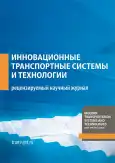Numerical 3D modeling of magnetic systems based on closed superconducting rings
- 作者: Pokrovskii S.V.1, Martirosian I.V.1, Aleksandrov D.A.1
-
隶属关系:
- National research nuclear university MEPHI
- 期: 卷 10, 编号 4 (2024)
- 页面: 537-555
- 栏目: Original studies
- URL: https://bakhtiniada.ru/transj/article/view/277924
- DOI: https://doi.org/10.17816/transsyst637429
- ID: 277924
如何引用文章
全文:
详细
Aim. To compare the magnetic characteristics and levitation force of single-cut and double-cut closed HTS rings.
Methods. Numerical calculations were performed using the finite element method in the Comsol Multiphysics software.
Results. The vertical magnetization profiles were obtained for single- and double-slit HTS rings magnetized under a gradient magnetic field and a permanent magnet's field. The normalized levitation force was analyzed based on the number of winding layers for both closed and nonclosed configurations. The nonclosed winding was found to generate the highest levitation force, namely 10% greater than that of a single-cut closed winding and nearly double that of a double-cut closed winding.
Conclusion. Numerical models were developed to simulate the magnetization process of closed-loop elements made from second-generation HTS tapes in the gradient field of a permanent magnet. The modeling was performed using the finite element method with both the magnetic field strength (H-formulation) and A-formulation (magnetic vector potential). Closed HTS ring systems with single and double cuts were analyzed. The models were verified by comparing the numerical results with experimental data obtained through scanning Hall magnetometry.
作者简介
Sergey Pokrovskii
National research nuclear university MEPHI
编辑信件的主要联系方式.
Email: sergeypokrovskii@gmail.com
ORCID iD: 0000-0002-3137-4289
SPIN 代码: 6643-7817
Candidate of Sciences in Physics and Mathematics, Head of the Laboratory
俄罗斯联邦, MoscowIrina Martirosian
National research nuclear university MEPHI
Email: mephizic@gmail.com
ORCID iD: 0000-0003-2301-1768
SPIN 代码: 3368-8809
Candidate of Science in Physics and Mathematics, research engineer
俄罗斯联邦, MoscowDmitrii Aleksandrov
National research nuclear university MEPHI
Email: cfrfcfrfdima123@gmail.com
ORCID iD: 0009-0001-7383-0094
SPIN 代码: 5365-6190
research engineer
俄罗斯联邦, Moscow参考
- Tomita M, Murakami M. High-temperature superconductor bulk magnets that can trap magnetic fields of over 17 tesla at 29 K. Nature. 2003;421(6922):517–520. doi: 10.1038/nature01350
- Patel A, Baskys A, Mitchell-Williams T, et al. A trapped field of 17.7 T in a stack of high temperature superconducting tape. Superconductor Science and Technology. 2018;31(9):09LT01. doi: 10.1088/1361-6668/aad34c
- Kovalev L, Ilushin K, Koneev S, et al. Hysteresis and reluctance electric machines with bulk HTS rotor elements. IEEE transactions on applied superconductivity. 1999;9(2):1261–1264. doi: 10.1109/77.783530
- Muta I, Jung H, Nakamura T, et al. Performance of axial-type motor with Bi-2223 HTS bulk rotor. Physica C: Superconductivity. 2002;372:1531–1534. doi: 10.1016/S0921-4534(02)01078-X
- Matsuzaki H, Kimura Y, Morita E, et al. HTS bulk pole-field magnets motor with a multiple rotor cooled by liquid nitrogen. IEEE transactions on applied superconductivity. 2007;17(2):1553–1556. doi: 10.1109/TASC.2007.898488
- Hirakawa M, Inadama S, Kikukawa K, et al. Developments of superconducting motor with YBCO bulk magnets. Physica C: Superconductivity. 2003;392:773–776. doi: 10.1016/S0921-4534(03)01213-9
- Netter D, Leveque J, Ailam E, et al. Theoretical study of a new kind HTS motor. IEEE transactions on applied superconductivity. 2005;15(2):2186–2189. doi: 10.1109/TASC.2005.849608
- Gao Y, Wang W, Wang X, et al. Design, fabrication, and testing of a YBCO racetrack coil for an HTS synchronous motor with HTS flux pump. IEEE Transactions on Applied Superconductivity. 2020;30(4):1–5. doi: 10.1109/TASC.2020.2971453
- Ueno E, Kato T, Hayashi K. Race-track coils for a 3 MW HTS ship motor. Physica C: Superconductivity and its Applications. 2014;504:111–114. doi: 10.1016/j.physc.2014.03.015
- Tomkow L, Harca I, Machaj K, et al. Experimental system for testing a superconducting motor at temperatures close to 15 K. Cryogenics. 2020;112:103206. doi: 10.1016/j.cryogenics.2020.103206
- Climente-Alarcon V, Smara A, Tomkow L, et al. Testing of surface mounted superconducting stacks as trapped-flux magnets in a synchronous machine. IEEE Transactions on Applied Superconductivity. 2020;30(5):1–8. doi: 10.1109/TASC.2020.2976603
- Martins FGR, Sass F, Ferreira AC, et al. A novel magnetic bearing using REBCO double crossed loop coils. IEEE Transactions on Applied Superconductivity. 2018;28(4):1–5. doi: 10.1109/TASC.2018.2813371
- Levin GA, Barnes PN, Murphy J, et al. Persistent current in coils made out of second generation high temperature superconductor wire. Applied Physics Letters. 2008;93(6). doi: 10.1063/1.2969798
- Santos BMO, dos Santos G, dos Reis Martins FG, et al. Magnetic bearings with double crossed loops modelled with TA formulation and electric circuits. Superconductivity. 2023;7:100058. doi: 10.1016/j.supcon.2023.100058
- Sheng J, Zhang M, Wang Y, et al. A new ring-shape high-temperature superconducting trapped-field magnet. Superconductor Science and Technology. 2017;30(9):094002. doi: 10.1088/1361-6668/aa7a51
- Ali MZ, Zheng J, Huber F, et al. 4.6 T generated by a high-temperature superconducting ring magnet. Superconductor Science and Technology. 2020;33(4):04LT01. doi: 10.1088/1361-6668/ab794a
- Barnes G, McCulloch M, Dew-Hughes D. Computer modelling of type II superconductors in applications. Superconductor Science and Technology. 1999;12(8):518. doi: 10.1088/0953-2048/12/8/308
- Brambilla R, Grilli F, Martini L. Development of an edge-element model for AC loss computation of high-temperature superconductors. Superconductor Science and Technology. 2006;20(1):16. doi: 10.1088/0953-2048/20/1/004
- Coombs T, Campbell A, Murphy A, et al. A fast algorithm for calculating the critical state in superconductors. COMPEL-The international journal for computation and mathematics in electrical and electronic engineering. 2001;20(1):240–252. doi: 10.1108/03321640110359967
- Huber F, Song W, Zhang M, et al. The TA formulation: an efficient approach to model the macroscopic electromagnetic behaviour of HTS coated conductor applications. Superconductor Science and Technology. 2022;35(4):043003. doi: 10.1088/1361-6668/ac5163
- Morandi A. 2D electromagnetic modelling of superconductors. Superconductor Science and Technology. 2012;25(10):104003. doi: 10.1088/0953-2048/25/10/104003
- Mykola S, Fedor G. A–V formulation for numerical modelling of superconductor magnetization in true 3D geometry. Superconductor Science and Technology. 2019;32(11):115001. doi: 10.1088/1361-6668/ab3a85
- Campbell AM. A new method of determining the critical state in superconductors. Superconductor Science and Technology. 2007;20(3):292. doi: 10.1088/0953-2048/20/3/031
- Anischenko I, Pokrovskii S, Rudnev I, Osipov M. Modeling of magnetization and levitation force of HTS tapes in magnetic fields of complex configurations. Superconductor Science and Technology. 2019;32(10):105001. doi: 10.1088/1361-6668/ab2bbe
- Osipov M, Starikovskii A, Anishenko I, et al. The influence of temperature on levitation properties of CC-tape stacks. Superconductor Science and Technology. 2021;34(4):045003. doi: 10.1088/1361-6668/abe18e
补充文件













